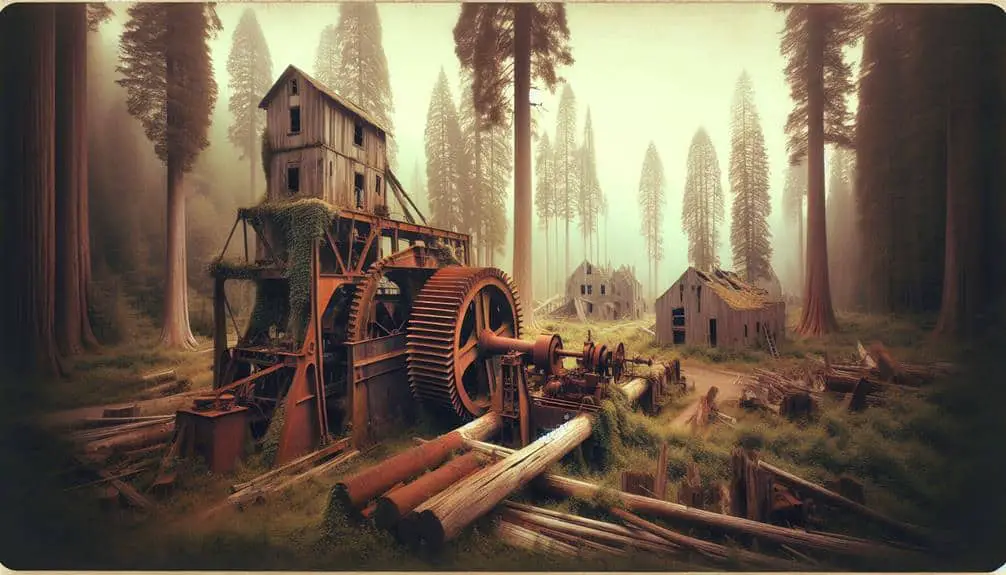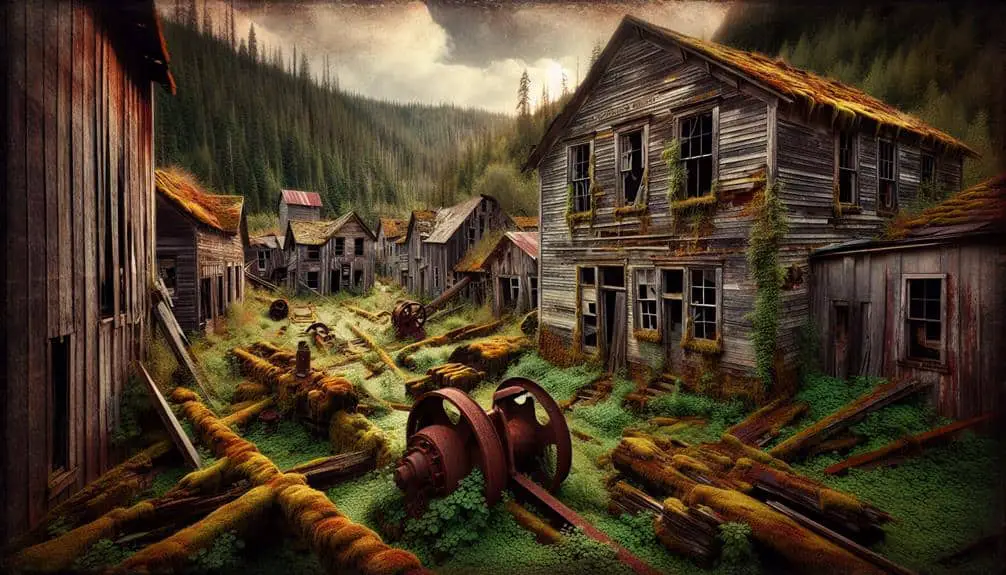Uncover timber harvesting ghost towns with caution. Wear proper gear for safety. Hire local guides for maneuvering through potential dangers. These towns hold historical significance and hidden treasures worth exploring. The eerie atmosphere reveals stories of past resilience and dedication. Decaying structures paint a vivid picture of a bygone era. Investigate company records and historical archives for a deeper understanding. Oral histories offer unique insights into past logging operations. Gain a better appreciation for the techniques and practices that shaped the landscape. Take necessary safety precautions, and remember, each ghost town has a story waiting to be discovered.
Key Points
- Wear proper safety gear to navigate hazards in ghost towns.
- Hire local guides for insights into the area and its dangers.
- Explore decaying structures for historical significance and hidden treasures.
- Investigate company records and archives for deeper understanding.
- Uncover oral histories for unique insights into logging operations.
Exploring Abandoned Logging Camps
When setting out on the journey to discover timber harvesting ghost towns, exploring deserted logging camps provides a unique glimpse into the historical significance of the industry. Hidden treasures await those who venture into these abandoned sites, offering a glimpse into the past glory of the logging era. The eerie silence that envelops these camps whispers haunting tales of the workers who toiled in the harsh wilderness to harvest timber for a growing nation.
As you wander through the remnants of old cabins and rusted equipment, you can almost hear the echoes of the past, envisioning the bustling activity that once filled these now desolate spaces. The decaying structures stand as a testimony to a bygone era, where men and machines worked together to extract the valuable timber resources that fueled economic progress.
Exploring these abandoned logging camps allows you to connect with history in a tangible way, unraveling the stories of resilience and hardship that characterized the logging industry. By delving into these forgotten sites, you not only unearth hidden treasures but also gain a deeper appreciation for the challenges faced by those who shaped the landscape with their labor.
Researching Historical Logging Operations
To gain insights into the historical logging operations that shaped the landscape, researching primary sources such as company records and historical documents is essential. Conducting thorough historical research allows you to understand the techniques and practices used in logging operations of the past.
Here are three key steps to explore further into the history of logging:
- Company Records: Examine the records of logging companies involved in timber harvesting activities. These records often contain valuable information about the locations of logging sites, the equipment used, and the volume of timber extracted.
- Historical Documents: Immerse yourself in archives, libraries, and online resources to uncover historical documents related to logging operations. Journals, newspapers, and government reports can provide detailed accounts of logging techniques employed during different time periods.
- Oral Histories: Interviewing individuals with knowledge of past logging activities can offer unique insights. Local residents, descendants of loggers, or historians specializing in logging history may share firsthand experiences and anecdotes about logging techniques used in the area.
Safety Precautions for Visiting Ghost Towns
Visitors to ghost towns should prioritize safety by adhering to recommended precautions and guidelines. When exploring these abandoned sites, it's vital to wear appropriate safety gear such as sturdy shoes, gloves, and helmets to protect yourself from potential hazards like sharp debris or unstable structures. Additionally, consider bringing along a first aid kit in case of minor injuries.
To enhance your safety further, it's advisable to hire local guides who are familiar with the area. These guides can provide valuable insights into the history of the ghost town and help navigate any challenging terrain. They can also warn you about specific dangers or restricted areas to avoid.
Remember that ghost towns can be unpredictable environments, with hidden dangers lurking around every corner. By taking these safety precautions and enlisting the help of experienced guides, you can make the most of your visit while ensuring your well-being.
Frequently Asked Questions
What Equipment Is Necessary for Exploring Abandoned Logging Camps?
When exploring abandoned logging camps, you'll need key equipment like sturdy boots, a headlamp, and a compass. Safety precautions include packing first aid supplies and informing someone of your plans. Stay safe while unraveling history's mysteries.
Are There Any Regulations or Laws Regarding the Preservation of Historical Logging Operations?
Preservation efforts aiming to protect historical logging operations are guided by regulations and laws. These measures guarantee the significance of these sites is maintained for future generations. Adherence to these rules is vital.
How Can One Identify Potential Hazards in a Ghost Town Before Visiting?
Prior to visiting, make sure you prioritize exploration safety by identifying potential hazards in a ghost town. Hidden dangers like unstable structures, old machinery, and environmental risks can pose serious threats. Stay alert and cautious.
Are There Any Local Legends or Folklore Associated With the Ghost Towns?
Explore the eerie past of ghost towns through haunted stories and spooky rumors. Uncover forgotten tales and local myths that have been passed down through generations, adding an element of mystery to these abandoned settlements.
What Steps Should Be Taken to Ensure the Protection and Conservation of These Abandoned Logging Sites?
To guarantee protection and conservation of abandoned logging sites, you must conduct thorough environmental impact assessments. Recognize their historical significance, implement sustainable management practices, involve local communities, and advocate for preservation efforts. The past deserves respect and preservation.



